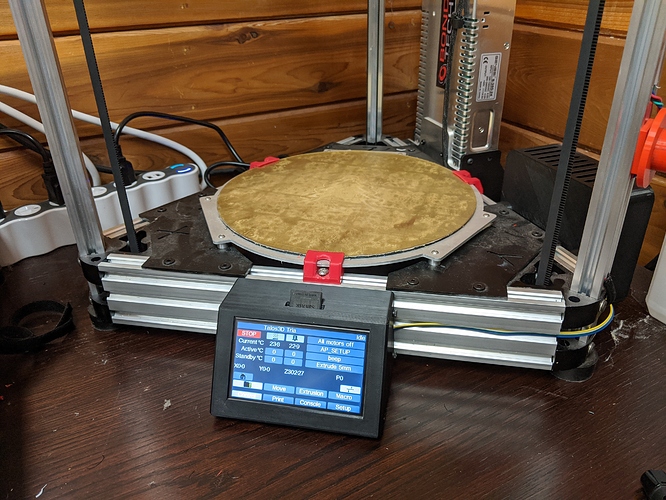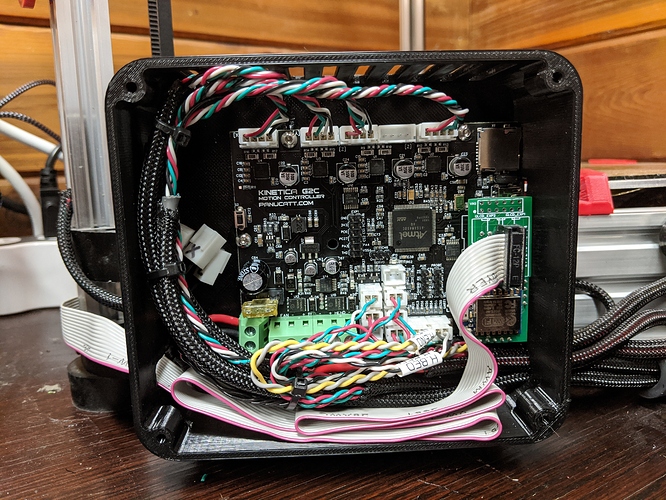Well, current limit is basically always max(chipsetLimit, implementationThermalMax) so it’s unlikely to be more than 2.8A but I don’t know the thermal analysis that Panucatt has done for their implementation. So I’d rather not put a guess there that Panucatt isn’t standing behind. I tried to only put current limits into the table that I could find documentation of some sort that came from what I understood to be someone responsible for design… ![]()
But overall, integrated was precisely because it’s usually better for overall current capacity at least if done right; the massive heatsinks on the high-current stepsticks feel to me like a hack.
I’ve added a firmware column to the table. Probably a bunch of these can run multiple firmwares and I should update the table.
The G2C has some nice vias and heat sinking pads so I think it should be able to push the current as far as is reasonable with those drivers anyway. I like socketed drivers for the ability to swap them out when the new hotness comes along. But I agree there really isn’t a substitute for the thermals you get with nice integrated stepper drivers on a board with good heat sinking capacity.
That’s one reason I’ve always appreciated Roy’s hardware designs, they’re built like a brick $#!+ house. I’ve overdriven the MOSFET for one of my heated beds at 24 volts with one of his boards for more than 5 years, with zero issues. I keep telling myself as soon as it fails I’m going to switch that particular printer over to an SSR with 120-volt bed. But it just refuses to die even though I’m running the bed at around 130% of its rated capacity.
Good enough, “2.8A?” makes sense to me then. It seems unlikely that Roy did less work on thermal management than BTT, given their relative reputations! 
The only difficulty with Roy is that sometimes he can go MIA for a little while from a support standpoint. Less so for me because I know a few more ways of getting a hold of him, and I worked with them on projects and testing a lot of his prototype boards for years. But I think being a small shop and having to do all the work himself (design, documentation, tech support, sales, etc) sometimes taxes his energy. Good thing is there’s a lot of resources out there and for the most part most of my questions end up being software related not hardware anyway.
BTT is coming out with a new version of SKR MINI, V2. Hardware UART support for the 2209 instead of bit-banging, four layer board with better thermal handling, protection from shorted thermistor, and more. Looks like still mini-usb instead of micro.
Unfortunately they are still mixing port pinout, which makes it hard for grbl-LPC. Only stepper channels X, Y and E0 would probably work.
Works fine for Marlin, though! When I glanced at grbl-LPC source it looked like changing some macros to functions and building them out would be all that would be required to add that functionality, but I didn’t need to do it so I didn’t go down that rabbit hole. 
Sure it would be possible to rewrite grbl-LPC, but it would be a lot of work and move it far away from the upstream branch. On the hardware side it would be rather simple to just use different pins and route them accordingly (if BTT was aware of the problem).
Noting that this is in the 3D Printing: Electronics category — is grbl-LPC normally used for 3D printers?
Thaks for the hint. I didn’t realize the category. Grbl-LPC is indeed not usable for 3d printing, but the board would also be interesting for laser modders, if pinout was clean.
Just as an FYI, the Prusa Buddy board has integrated TMC drivers, although if bought from Prusa the stock bootloader only loads firmware signed by Prusa. There are versions from third parties that don’t have this limitation and are also cheaper.
I’m planning a Prusa Mini clone build, but I’ll probably use SKR Mini.
Thanks! I think they let you cut a warranty-voiding line to load your own firmware? Do you happen to know which TMC chips they are using? (I should start listing original and clones as separate lines in the table since clones aren’t necessarily quite the same thing.)
Yes, there is a breakable tab to enable unsigned firmware. The drivers are TMC2209.
I’ve not had any issues with the board (I have Prusa Mini), the LCD display is quite nice as it can display a preview of the GCode file for you when you forget what the heck flooble_PLA_0.2mm.gcode on that USB stick actually is (which is most of the time for me  ).
).
Not sure it is worth the cost for a budget printer though. I might try one of the clone Buddy boards, I am waiting for feedback from people who have bought the Mini clone kits.
This evening, I got the dreaded TMC CONNECTION ERROR and one of my A/B motors isn’t turning, so one of the 2209s on my BIGTREETECH SKR Mini E3 V1.2 died. BIGTREETECH Direct SKR Mini E3 V2.0 (which has some added features, I think including protection against thermistor short circuits) is $45, but right now BTT on Amazon have a 5% off and free “BIGTREETECH DIRECT TFT35 V2.0 Smart Controller WiFi Display” and I can get it Monday and get the printer working again over the holiday break. So I’m not committed to staying on the BTT boards but as things go it is a cheap enough fix.
I also noted that there is a FYSETC board with 4 TMC2209s for $29 and added it to the matrix, but there wasn’t a lot of information on the Amazon page.
In the long run, I think I want to upgrade to something different but can’t decide what yet. Too many other things to think about.
Edit: Received the V2.0 today. Among other changes, it no longer exports STEP/DIR/EN signals for external steppers, making it harder to repurpose. It also doesn’t have a jumper to select “SPREAD” mode. I’m hoping that doesn’t matter. Thermal management looks better than the V1.2.
The spread cycle versus hybrid is now set with uart not with the jumper. The thermals on the version 2 is a lot better. I’ve been liking BTT recently because they actually put a reasonable amount of information out on their github. Unlike most Chinese manufacturers. And they update the display regularly, I run a skin on mine to make it so it isn’t so ugly, but it’s a really usable interface.
Ah. In my clone of git@github.com:bigtreetech/BIGTREETECH-SKR-mini-E3.git I did git pull and then diff -uNr firmware/V1.2/Marlin-2.0.7.2-SKR-mini-E3-V1.2 firmware/V2.0/Marlin-2.0.7.2-SKR-mini-E3-V2.0 and that brought enlightenment. ![]()
I expect to be flashing this shortly.
I note that they are still showing the heat sinks on the chips instead of on the back of the board as I’ve recently learned probably makes more sense.
Maybe I’ll rebuild firmware for the old V1.2 with the dead TMC chip without TMC support and use it to drive monocle ![]()
I didn’t know that the 2209s run cooler than the 2208s, but that’s at least what this article says:
In particular, this:
The flexible and stealthy TMC2130 has 400 (bottom) and 500mΩ (top) (100mA 25°C supply=24V) mosfets, and runs hot – needing a larger heatsink to keep it working.
TMC2208 is a later generation, with 280mΩ (100mA 25°C supply=24V) mosfets, – although some folk say they still run hotter than A4988, but there is a lot of hearsay in the 3D print world, and I haven’t tried them, so maybe they are similar, or maybe StealthChop requires the mosfets to operate partially in linear mode, or maybe when people use them at 12V the transistors do not achieve 280mΩ.
Anyway, just introduced, the TMC2209 has 170mΩ (200mA 25°C supply=24V) mosfets – which must cut dissipation to some extent, and might even mean heatsinks can be done away if they are directly on a large pcb with plenty of copper – thick layers and lots of layers.
Just added the Duet 3 Mini 5+, which has 5 TMC2209s. Looks like it’s not in stock yet so I haven’t found US pricing.


